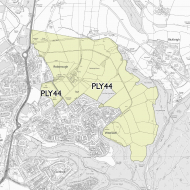PLY44 - Woolwell sustainable urban extension and community park
The Plymouth and South West Devon Joint Local Plan has now been adopted! To find out more please visit the Plymouth and South West Devon Joint Local Plan: Adoption page.
Visit the interactive Plymouth Plan to see other policies that affect decision making across Plymouth City including the Council and its partners.
Land at Woolwell is allocated for comprehensive residential led mixed use development to provide a sustainable urban extension and a defined edge to the north of the city, including a new community park. Provision is made for in the order of 2,000 new homes (about 1,560 of which are anticipated to come forward within the plan period). Development should provide for the following:
- Delivery in accordance with a strategic masterplan and design code that should be prepared for the site and consulted upon in advance of the consideration of any planning application. This masterplan will:
- Identify the design philosophy and phasing of the development.
- Include a detailed transport and access strategy which establishes key road, walking and cycling routes and public transport, maximising the permeability of the site by all forms of sustainable transport, both within the development and to connecting routes in the vicinity.
- Set out a landscape strategy that responds to the sites location and relationship with Dartmoor National Park.
- The main access arrangements are to be agreed prior to the commencement of development and delivered commensurately with the associated phase of the development. Additionally, there should be no occupation of new homes until the A386 Woolwell to the George Junction Transport Scheme has been implemented, with the exception of where this can be accommodated without resulting in a severe impact on the operation of the local road network.
- A form of development which utilises natural features with appropriate strategic landscaping that is sensitive to its location and relationship with the Dartmoor National Park resulting in a clearly defined edge of the city.
- Delivery of a new Community Park that will form part of the network of Strategic Greenspace sites. It will therefore need to be of a sufficient scale, design and quality and must be multi-functional in nature. The park must:
- Meet the recreational needs of the new community to prevent an unacceptable impact on South Dartmoor Woods European Protected Site.
- Provide a minimum of a 40m landscape buffer between the edge of development and the Plym Valley Strategic Green Space and setting of Dartmoor National Park.
- Deliver high quality accessible greenspace that incorporates areas for active recreation and play in line with local standards.
- Provide a high quality network of walking, cycling and horse riding routes through the Park that link into the adjacent Plym Valley Strategic Green Space.
- Incorporate elements of the Sustainable Urban Drainage system that must be designed to fit within the landscape setting of the Park and provide wildlife and amenity benefits.
- Incorporate new playing pitches in line with local standards and associated infrastructure, such as changing rooms, required to support the new community. Facilities will be located in an appropriate area that does not conflict with the other functions of the park.
- Mitigate the impacts of the development on biodiversity and incorporate biodiversity enhancement measures.
- Utilise the old tramway for pedestrian and cycle connections through the development and providing the opportunity for onward links to the Plym Valley Strategic Green Space.
- Appropriate local facilities to support the new and existing residents and to enhance the sustainability of the area, including a new primary school and appropriate contributions to mitigate the development on secondary schools in Plymouth.
- A second road access to Woolwell which is capable of accommodating traffic from the existing community and planned new development, with due consideration to the needs of public transport accessibility, and which leads to improved traffic flow around the area and which reduces the impact of the development on the key transport corridor and routes.
- Contributions to strategic highway improvements and programmes.
- Provision of opportunities and plots for self or custom build homes.
- Maximise opportunities for on-site energy generation.


